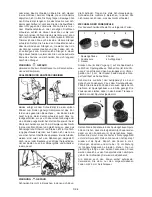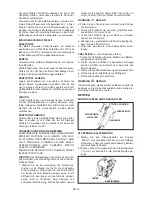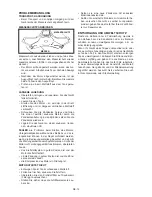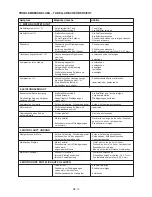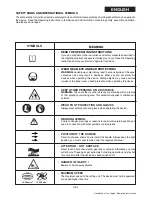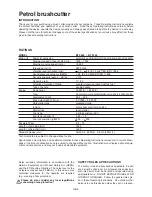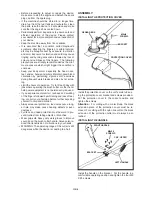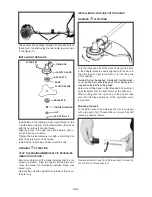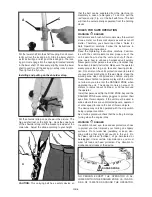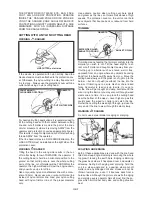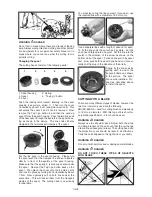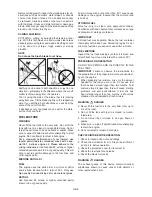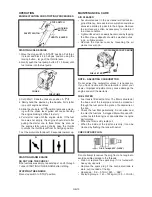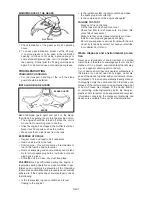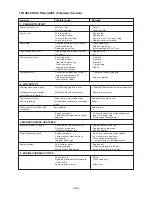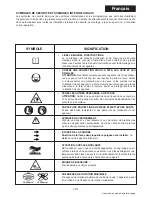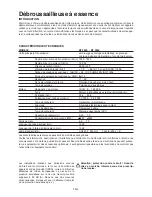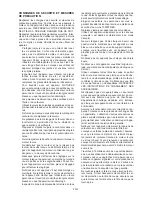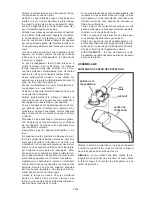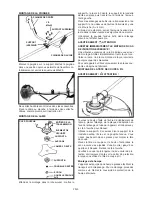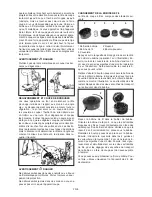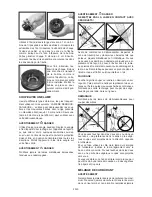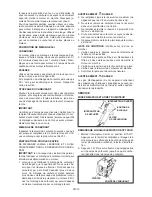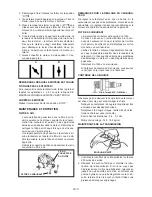
Before cutting growth, inspect the working area for ob-
structions such as boulders, metal stakes or strands
of wire from broken fences. If an obstruction cannot
be removed, mark its location so that you can avoid it
with the blade. Rocks and metal will dull or damage a
blade. Wire may get caught in the blade head and flap
around or be thrown into the air.
SAWING SAPLINGS
SCYTHING - cutting by swinging the blade in a level
arc. With this technique one can quickly clear areas
densely grown with grass and weeds. Scything should
not be used to cut large, tough weeds or woody
growths.
NOTE
Do not use the brush blade to cut trees.
Scything can be done in both directions, or just in one
direction – preferably in the direction where the cut-off
matter is thrown away from the operator.
That is using the side of the blade that it is rotating
away from you. Tilt the blade slightly on the respective
side. If you scythe in both directions you will be hit by
some of the cut-off matter.
If kickback occurs, the blade may be dull or the mate-
rial too thick and hard.
FUEL MIXTURE
WARNING
Never fill the fuel tank to the very brim. Do not fill the
tank with fuel in a closed, non-ventilated area. Do not
refuel the unit close to an open flame or sparks. Make
sure to wipe off spilled fuel before attempting to start
engine. Do not attempt to refuel a hot engine.
For a maximum performance of your trimmer, use
regular petrol (two-star, unleaded) mixed with a spe-
cial 30:1 2-stroke engine oil. Please adhere to the
mixing instructions.
Use branded 89 octane or higher
unleaded petrol known to be of good quality. This will
help to avoid possible damage to the fuel lines and
other engine parts.
MIXTURE RATIO 30:1
FUEL
The engine uses two-stroke fuel, a mixture of petrol
and 2-stroke lubricant with a ratio of 30:1.
Only use
high-quality 2-stroke mixing oil for air-cooled engines.
PETROL
Use branded 89 octane or higher unleaded petrol
known to be of good quality.
Fuel mixtures with a rate other than 30:1 may cause
damage to the engine. Ensure that the mixture ratio
is correct.
STORING FUEL
Store fuel only in a clean, safe, approved container.
Familiarise with and observe local ordinances on type
and location of storage containers.
IMPORTANT
2-stroke fuel may separate. Shake the fuel container
thoroughly before each use. Stored fuel ages. Do not
mix more fuel than you expect to use within a month.
FUEL MIXTURE
Inspect the fuel tank making sure that it is clean and
fill with fresh fuel. Use a mixture with a ratio of 30:1.
PREPARING FOR OPERATION
DO NOT MIX PETROL AND OIL DIRECTLY IN THE
FUEL TANK.
IMPORTANT
: Failure to observe the instructions for
the preparation of the proper fuel mix may cause dam-
age to the engine.
1. When preparing fuel mixture, mix only the amount
needed for the job you are to do. Do not use fuel
that has been stored longer than two months. Fuel
mixture stored longer than this will cause starting
problems and poor performance. If fuel mix has
been stored longer than two months, it should be
disposed of and replaced by fresh mixture.
WARNING
DANGER
2. Never fill the fuel tank to the very brim (only up to
3/4 of the tank).
3. Do not fill the tank with fuel in a closed, non-venti-
lated area.
4. Do not refuel the unit close to an open flame or
sparks.
5. Make sure to wipe off spilled fuel before attempting
to start the engine.
6. Do not attempt to refuel a hot engine.
CHECKPOINTS BEFORE OPERATION:
1. Check for loose bolts, nuts and fittings.
2. Check the air cleaner for dirt. Clean the air filter of
all dirt, etc. before operation.
3. Check the protection cover for its correct fit.
4. Check the fuel tank for any leaks.
5. Check the blade for cracks.
WARNING
DANGER
The exhaust gases of this device contain chemical
substances known to cause cancer, birth defects or
other reproductive harm.
GB-9

